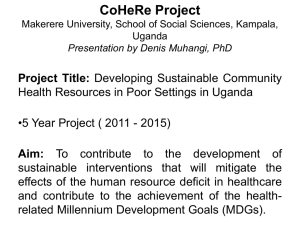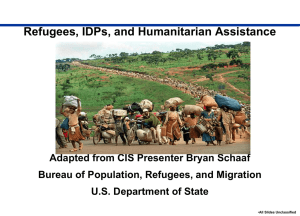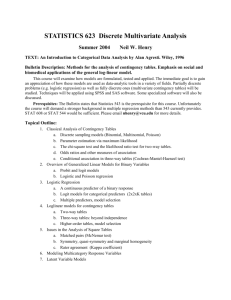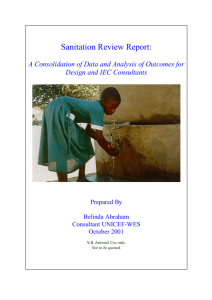Table S4. Extracted data PUBLISHED LITERATURE Reference
advertisement
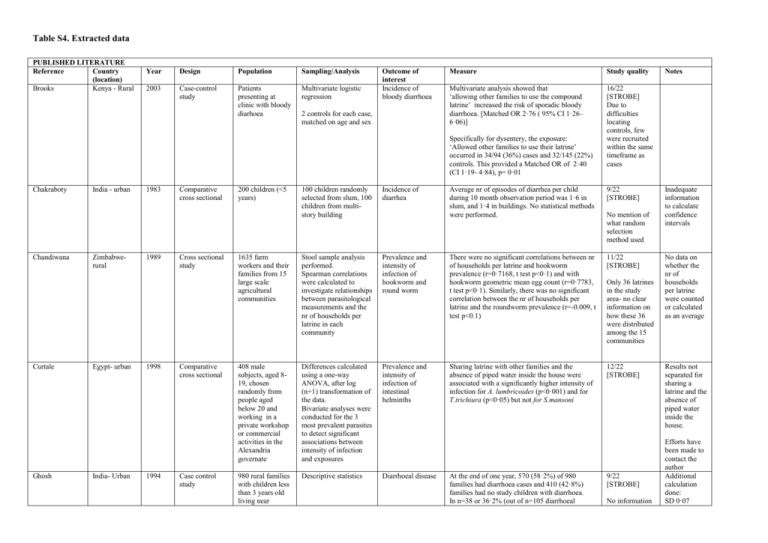
Table S4. Extracted data PUBLISHED LITERATURE Reference Country (location) Brooks Kenya - Rural Year Design Population Sampling/Analysis 2003 Case-control study Patients presenting at clinic with bloody diarhoea Multivariate logistic regression Outcome of interest Incidence of bloody diarrhoea 2 controls for each case, matched on age and sex Measure Study quality Multivariate analysis showed that ‘allowing other families to use the compound latrine’ increased the risk of sporadic bloody diarrhoea. [Matched OR 2·76 ( 95% CI 1·26– 6·06)] 16/22 [STROBE] Due to difficulties locating controls, few were recruited within the same timeframe as cases Specifically for dysentery, the exposure: ‘Allowed other families to use their latrine’ occurred in 34/94 (36%) cases and 32/145 (22%) controls. This provided a Matched OR of 2·40 (CI 1·19- 4·84), p= 0·01 Chakraboty Chandiwana Curtale Ghosh India - urban Zimbabwerural Egypt- urban India- Urban 1983 1989 1998 1994 Comparative cross sectional Cross sectional study Comparative cross sectional Case control study 200 children (<5 years) 100 children randomly selected from slum, 100 children from multistory building Incidence of diarrhea Average nr of episodes of diarrhea per child during 10 month observation period was 1·6 in slum, and 1·4 in buildings. No statistical methods were performed. 9/22 [STROBE] 1635 farm workers and their families from 15 large scale agricultural communities Stool sample analysis performed. Spearman correlations were calculated to investigate relationships between parasitological measurements and the nr of households per latrine in each community Prevalence and intensity of infection of hookworm and round worm There were no significant correlations between nr of households per latrine and hookworm prevalence (r=0·7168, t test p<0·1) and with hookworm geometric mean egg count (r=0·7783, t test p<0·1). Similarly, there was no significant correlation between the nr of households per latrine and the roundworm prevalence (r=-0.009, t test p<0.1) 11/22 [STROBE] 408 male subjects, aged 819, chosen randomly from people aged below 20 and working in a private workshop or commercial activities in the Alexandria governate Differences calculated using a one-way ANOVA, after log (n+1) transformation of the data. Bivariate analyses were conducted for the 3 most prevalent parasites to detect significant associations between intensity of infection and exposures Prevalence and intensity of infection of intestinal helminths Sharing latrine with other families and the absence of piped water inside the house were associated with a significantly higher intensity of infection for A. lumbricoides (p<0·001) and for T.trichiura (p<0·05) but not for S.mansoni 12/22 [STROBE] 980 rural families with children less than 3 years old living near Descriptive statistics Diarrhoeal disease At the end of one year, 570 (58·2%) of 980 families had diarrhoea cases and 410 (42·8%) families had no study children with diarrhoea. In n=38 or 36·2% (out of n=105 diarrhoeal No mention of what random selection method used Only 36 latrines in the study area- no clear information on how these 36 were distributed among the 15 communities 9/22 [STROBE] No information Notes Inadequate information to calculate confidence intervals No data on whether the nr of households per latrine were counted or calculated as an average Results not separated for sharing a latrine and the absence of piped water inside the house. Efforts have been made to contact the author Additional calculation done: SD 0·07 Calcutta Golding Hall Jamaica Urban BangladeshUrban 1994 1994 Comparative cross sectional Comparative cross sectional 9919 mothers delivering a singleton in a specified 2 month period and 1847 mothers who delivered a singleton perinatal death in a contiguous 12 month period Stool samples from 880 residents of an urban slum in Dhaka were collected on 3 occasions over 1 year Chi-squared tests Logistic regression Perinatal death Antepartum fetal death families) shared a latrine, whereas n=7 or 15·9% (out of n=49) non-diarrhoeal families shared latrines. This is stat sig at p=0·008 (CI not presented in study) on how control families were selected Increased risk of perinatal death among women who had to share toilet facilities. This was associated especially with antepartum fetal deaths (p<0·001) 14/22 [STROBE] 95% CI: 0·08-0·32 If the toilet was used by people other than family: Logistic regression analysis Adjusted OR for predict antepartum fetal death 1·62 [95% CI 1·28,2·03] Questionnaire Stool samples Strongyloides stercoralis infection No information on how respondents were selected for questionnaire or stool sample Adjusted OR to predict perinatal death using social and environmental factors: 1·41 [95% CI 1·21-1·64] Proportion of individuals infected with S. stercoralis (at any of the 6-monthly examinations) 13/22 [STROBE] Site of children’s defaecation No.infect. OR CI Own latrine 18/217 (8·3%) Shared latrine 7/157 (4·5%) 0·52(0·221·24) Community lat 35/194 (18·0%) 2·43(1·354·38) Indiscriminate 41/294 (14·7%) 1.79(1·01-3·17) Site of respondents defecation No.infect. OR CI Own lat 17/234 (7.3%) - Khan Bangladeshurban 1987 Comparative cross sectional Inhabitants of two similar per-urban slums of Dhaka No mention of random selection of study sites Besides latrine provision, the two study sites were comparable Kim-Farley Taiwan- rural 1984 Case –control study Cases reporting through routine reporting channels or Study sites chosen because they represented contiguous rural areas with very Diarrhoea incidence and intestinal parasite prevalence (T. trichiura, E. hystolitica, G. lamblia, S.stercoralis) Poliomyelitis Shared lat 18/233(7.7%) 1.07(0.55-2.08) Comm lat 59/336(17.6%) 2.72 (1.57-4.72) Indiscrim. 8/71 (11·3%) 1·62 (0·68-3·88) The Kalsi area was provided with 5 communal latrines 10/22 [STROBE] In the Tongi area, 78% of the people used communal latrines, 6% used pit latrines and 16% had no definite latrine. In the Kalsi area, 69% used open pit latrines and 31% had no definite latrine. The rate of diarrhoea, from all causes, did not differ between the Tongi and Kalsi areas Univariate analysis of differences between case and non-case families in Yun Lin county. Toilets shared by families, cases had an OR of 4·0 13/22 [STROBE] Assuming latrines shared by families was through active surveillance system different attack rates. Log linear modelling and logistic regression analysis (1·9-8·3) compared to controls. (p value 0·0002) [n=32 cases, n=210 controls] No multivariate data presented Univariate analysis of differences between noncase families in Yun Lin and non-case families in Chia Yi counties. 24·3% of families (n=210) in Yun Lin shared latrines vs 15% in Chai Yi (n=200) Mahfouz Egypt – urban 1997 Cross sectional study Questionnaire from 1324 families Stool samples from 658 preschool children below 5 years of age Montgomery Munoz Tanzaniarural Australia-rural 2010 1992 Case control study Historical cohort Sub-study population (part of a larger case control) Children aged 1-5 years. All households in substudy with sentinel child with clinical signs of active trachoma. Control households were randomly selected from the area. Hospital admissions for 1961 children from 10 rural aboriginal communities in the Northern Territory Questionnaire Stool samples Intestinal parasites OR 1·6 (1·0-2·7) [p=0·0453] Exposure ‘Sharing toilets with other family‘ 13/22 [STROBE] Multivariate, adjusted Odds ratios Study site was chosen randomly, though method not described HELMINTHS 1·95(1·38-2·75) Multivariate analysis Maximum likelihood estimates of combined OR and their 95%CI adjusted for confounders Questionnaire, blinded to reduce interviewer bias Logistic regression modelling using generalised estimating equation techniques PROTOZOA 1·65(1·06-2·58) (both at p=0·1) Trachoma Sanitation sharing practices of households that used latrines 630 households were identified, 593 surveys were completed (92 cases 501 controls) for a response rate of 94% Generalised linear interactive modelling software was used to calculate the nr of admissions per childyear at risk (admission rate) for each community Hospital admissions Latrine sharing is practiced by 48·6% of cases and 47·0% of controls. Of all latrine sharing households, the largest proportion shares a facility with just one neighboring household (20·0% cases, 23·7% controls). The maximum number of households sharing a latrine was 9. Sharing among 5 or more households is rare (15 instances) and therefore, these were grouped in the category of “four or more households sharing a latrine.” Results indicate that shared latrines provide as much protection compared with private latrines in regard to risk of trachoma. Adjusted OR= 0·95 (0·55-1·67) The number of households sharing a latrine does not significantly alter the association In the factor analysis, communal toilets was of significant (p<0·01) importance. Authors note that these significance levels may be biased, but they indicate the relative importance of each variable for each factor. Most houses had inside toilets, but some had access only to communal toilets. (ranging from 060%) Although many community characteristics were strongly associated with differences in admission rates between communities, interferences about the causal significance of individual variables 13/22 [STROBE] 17/22 [STROBE] compared to latrines shared by more than just family cannot be made easily, because at least some of the association will be indirect and non-causal. Olusanya Nigeria urban 2010 Historical cross-sectional Women giving birth at an innercity tertiary maternity hospital- all live births were eligible for enrolment Cross tabulation Two-tailed chi square test Backward stepwise multivariable logistic regression Preterm birth and low birth weight Risk Factors for Low Birth weight: Living in a house with shared sanitation facilities (aOR, 1·27; 95% CI, 0·98–1·65) was retained in the model but had a weak association with low birth weight (P = 0·07). 18/22 [STROBE] Risk factors for prematurity Living in a house with shared sanitation facilities Prematurity final model,adjusted aOR (95% CI) = 1·26 (1·07–1·48) PAR (%) =11·18 Phiri Shultz Malawi – urban and rural Kenya- camp setting 2001 2009 cross sectional study Cases presenting at IRC camp hospital Children aged 314 years old residing in either of the two areas of investigations: a rural community and a very densely populated township Historical case control study Questionnaire and stool samples ANOVA Multiple logistic regression Maximum likelihood estimates obtained Clear and random sampling frame for areas of study described Standardised questionnaires administered to cases and controls Prevalence of Helminth infection (A. lumbricodes, T. trichiura, S. stercolralis) Watery diarrhoea Matched cases to controls by location of residence in the camp and age Tshikuka Brazil- urban DRC- Urban 2004 1995 Case control study Cross- sectional Children aged 1259 months with diarrhoea presenting at hospital 42 households in Aged-matched controls Acute diarrhoeal disease Questionnaire Multivariate logistic analysis Face-to-face interview 18/22 [STROBE] Sharing a latrine was not found to be a statistically significant exposure, thus not included in model 16/22 [STROBE] Camp settingall that different from very densely populated urban areas? Some of the non-significant variables (did not meet the p<0·1 criteria for inclusion in the multivariate analysis model), were sex and age of the child, parental occupation, sharing a latrine, source and storage containers of drinking water and geophagy. UNIVARIATE N=90 for cases N=170 for controls Exposure: Fifteen or more people sharing the same latrine Cases: 31/52 (60%) Controls:54/112 (48%) MOR 1·5 (0·7, 3·3) P value: 0·33 Exposure: Three or more households sharing same latrine Cases: 34/51 (67%) controls: 57/111 (51%) MOR 1·9 (0·9, 4·4) P value 0·11 Randomised control finding strategy Sobel Low birth weight final model, aOR (95% CI) =1·27 (0·98–1·65) (p=0·07) PAR (%) =12·52 73% of urban (n=195) shared a latrine, and 13% in rural (n=13) Ascaris MULTIVARIATE MOR Exposure: Three or more households sharing same latrine: MOR 2·17 (1·01–4·68) was associated with an increased risk of watery diarrhoea Risk factor associated with diarrheal illness in matched pairs of children: sharing toilet with other household MOR 1·48 (1·07-2·04) p=0·02 Multiple regression analysis results 16/22 [STROBE] 16/22 It is unclear survey each subdivision Stool sample from single index child randomly selected from each household Tuttle Zambia- urban 1995 Case control study Case patient presenting at clinic when interviewers were present Associations between infection and exposure variables were assessed by univariate and multivariate regression procedures for each subdivision independently MRA. Randomly selected subdivision 2 controls for each case matched by age and sex lumbricoides infection [STROBE] whether the persons/toilet were counted or calculated as an average “ It is possible that houses clustered together function in some ways as a single unit, with many forms of close contact occurring among household members” Persons per toilet: Beta= 0·45, coefficient 0·07 (S.E. 0·02). This was significant at p<0·01 Families who regularly defecated in the open had a mean number of 27.0 (S.E. 1·9) person/toilet whereas those who did not had a 18·6 (S.E. 1·4) persons/toilet. According to the authors, persons per toilet can be interpreted either as an index of sanitation or as an index of crowding. Therefore if there are more persons/toilet, it is more likely that people will (continue to) defecate in the open Shigella dysenteriae type I 64% of cases, versus 46% of controls shared latrines. OR=3·3 (1·1-10·2). p=0·3 15/22 [STROBE] Diarrhoeal disease Where data were available, 22/87 (25.3%) of cases and 69/291 controls (23.7%. p=0.763) reported sharing sanitation facilities with other households. An average of 2 households shared sanitation facilities in both cases (range 2-4) and controls (range 2-5). 19/22 [STROBE] Enteric infection with either S. Typhi or S. Paratyphi A. Cases using a household latrine versus those using a community latrine had an adjusted OR of 4.92 (1.2-19.5) for S. Parathyphi A. 17/22 [STROBE] Multivariate analysis used conditional logistic regression. Questionnaire Stool sample Moshabela Karkey Mahamud South Africarural Nepal- Urban Kenyarefugee camp 2012 2013 2012 Case- control Matched casecontrol Matched casecontrol Black African individuals reporting prevalent diarrhoea All febrile patients attending the outpatient or emergency department of Patan Hospital, Kathmandu Refugees and non-refugees presenting at Kakuma IRC with watery diarrhoea Univariate and multivariate logisitic regression. 3 randomly selected controls from same HIV clinic Matched univariate analysis, conditional logistic regression. Matched multivariate analysis. Bivariate analysis using matched conditional logistic regression. Multivariate conditional logistic regression. Cases using a household latrine versus those using a community latrine had an adjusted OR 7.26 (1.4-37.2) for S. Typhi. Watery diarrhoea/Cholera In total, 92.2% of cases used a household latrine, versus 77.9% of the controls. Sharing a communal latrine with neighbouring household was associated with an increased risk of illness (OR, 3.33 (1.34-8.30, p=0.001). Among the cases, 41% used a communal latrine, versus 23.9% of the controls. 15/22 [STROBE] pendix V GREY LITERATURE Author/ Year Title Institution Baker 2011 The risk of moderate and severe diarrhea in children less than 5 years old is increased among families who share a sanitation facility Country/ Type of document Various Conferenc e abstract Conclusions Quality criteria Reviewed notesNote Yes/not specified Outcome: diarrhoeal disease Families of case children more commonly used shared sanitation facilities than control families (47·5% vs. 41·2%, mOR = 1·2; 95% CI: 1·1–1·3), overall and in Pakistan (mOR=1·7; 1·4-2·0), Mali (mOR=1·2; 1·1-1·4), India (mOR=1·3; 1·0-1·6), and Kenya (mOR=1·2; 1·0-1·5). The odds of diarrhoea for shared sanitation were increased two-fold if feces was present (mOR=2·2; 1·6-3·2) than if was absent (mOR=1·2; 1·1-1·3) While access to unshared sanitation facilities was more common among higher-income households, shared sanitation facilities were consistently more common among case than among control households across all wealth index quintiles. Our observations indicate that shared sanitation facilities can increase the risk of diarrhea, regardless of the type of facility, and supports their classification as “unimproved”. Increasing access to private sanitation facilities may reduce diarrhea incidence among young children Inadequate information for proper assessment of study Abstract presented at ASTMH conference. Final data not yet published. Notes



